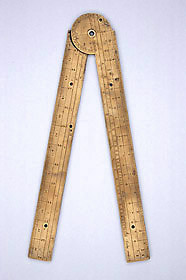
 |
| Catalogue |
 |
 Folding Rule With the limbs locked fully open, the instrument serves as a two foot rule, and it carries a scale of inches marked from 1 to 24. On one limb the inches are divided to 1/2 and subdivided to 1/4 and 1/8. On the other the inches are divided to provide scales of equal parts, for use with maps. Each inch is marked with the number of parts into which it is divided. The sequence of division is: 16, divided to 1/2, 1/4, 1/8 and 1/16; 32, divided to 1/2, 1/4, 1/8, 1/16 and 1/32; 64, divided to 1/2, 1/4, 1/8, 1/16, 1/32 and 1/64; 36, divided to 1/2, 1/6, 1/12 and 1/36; 24, divided to 1/2, 1/6, 1/12 and 1/24; 42, divided to 1/7, 1/14 and 1/42; 28, divided to 1/7, 1/14 and 1/28; 18, divided to 1/3, 1/9 and 1/18; 15, divided to 1/3 and 1/15; 20, divided to 1/5, 1/10 and 1/20; 22, divided to 1/2 and 1/22; 26, divided to 1/2 and 1/26. On the same side are scales and tables for calculating areas and volumes. The scales are titled 'Borde . measure' and 'Timber . measure' and are also used with the limbs fully open. These scales were the characteristic feature of the carpenter's rules of craft practice and their construction and use are described in Leonard Digges' Tectonicon of 1556. Both scales are divided and numbered to 1, the board scale running from 36 to 7 and the timber scale from 36 to 7. As recommended by Digges, the range of both of these scales is supplemented by a table arranged within the 1 to 12 inch scale. The two columns are headed 'T' and 'B', respectively, and provide the timber and board values from 12 inches to 1. On the inside edge of each limb, and running across the joint, is a scale of equal parts 500 to 0 to 500, divided to 10 and 2, and numbered by 10. Intended for use with the instrument locked fully open, this scale would have been used when the instrument was fitted with sights and serving as a plane table alidade. Thomas Digges' second edition of Pantometria (1591) gives a contemporary account of a ruler divided in this way as an alidade. As well as ensuring that his general-purpose folding rules could serve as plane table alidades, Cole also made such alidades in a more specifically dedicated form (Epact 37175). The joint carries a graduated semicircle of degrees running from 0 to 180 in both directions, divided to 10 and 2, and numbered by 10. The inner edge of the moveable limb serves as its index, and the scale is meant to be used when the limbs are at variable opening. In this configuration, the rule would be horizontally mounted by means of the central joint hole on a post or tripod. Observations would be taken with a pair of sights on each limb; the four necessary holes are marked 'A', 'B', 'C', and 'D'. The scales on the reverse of the instrument are for use with the instrument in its third configuration, with the limbs pegged open at right angles. Both a quadrant and shadow square are provided on one limb to measure vertical elevations. A hole in the other blank limb enables a plumb bob to be fitted. The degree scale of the 'Quadrans' runs 0 to 66, divided to 10, 5 and 1 and numbered by 5. The shadow square is titled 'Quadratum Geometricum' and is divided to 15, 5 and 1. Both the 'Latus Vmbra Versa' and the 'Latus Vmbra Recta' are numbered by 5 and run from 0 to 60 and 60 to 0, respectively. The instrument is signed at the end of the shadow square '[star] Humfrey . C?le . 1575 [star]'. This example of Cole's folding rule is the simplest to survive. Its features exactly tally with the functional elements present on Leonard Digges' version of the carpenter's rule. However Cole's instrument represents a redesign which not only increases the device's portability, but also ingeniously enables the measurement of horizontal angles for surveying as well as greatly improving the size and effectiveness of the quadrant and shadow square. Other examples of Cole's folding rules have features such as integral sights (Epact 42407) or additional scales and tables of measures (Whipple Museum, Cambridge). The example at the Science Museum, London includes a sundial to extend its mathematical coverage further. See G. L'E. Turner, "Mathematical Instrument-Making in London in the 16th Century", in S. Tyacke (ed.), English Map-Making 1500-1650 (London, 1983), pp. 93-106, at p. 103, and S. Johnston, "The Carpenter's Rule: Instruments, Practitioners and Artisans in 16th-Century England", in G. Dragoni, A. McConnell and G. Turner (eds), Proceedings of the Eleventh International Scientific Instrument Symposium (Bologna, 1994). Stephen Johnston |



